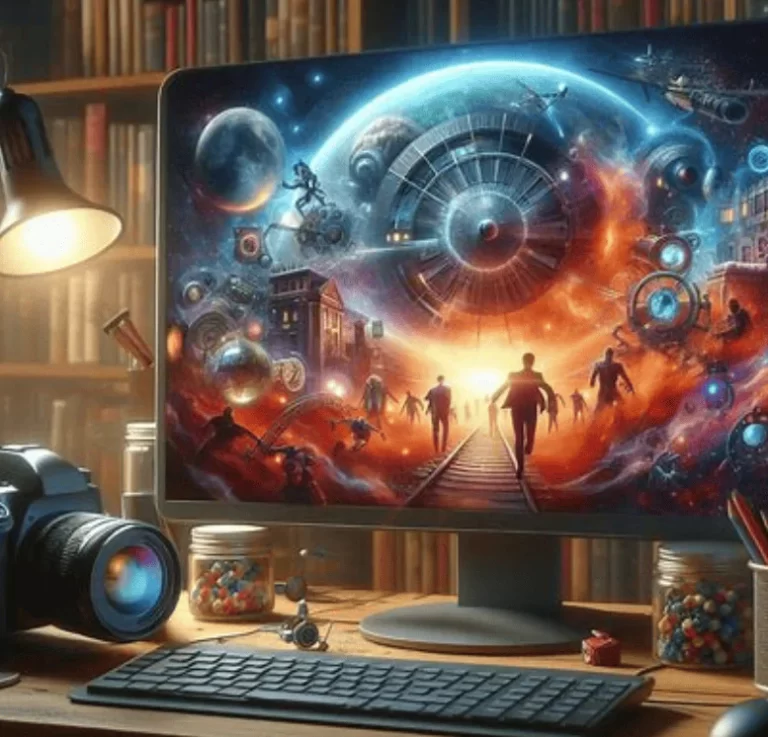
Digital Dreamscapes The line between reality and imagination has always been a source of fascination for humankind. In today’s technological era, that line is no longer just a philosophical construct but a tangible frontier shaped by the evolution of digital technology. Digital Dreamscapes, the immersive landscapes of the virtual realm, have emerged as a revolutionary phenomenon, allowing individuals to escape, create, and interact within worlds that transcend the boundaries of physical existence. These dreamscapes are not merely byproducts of entertainment but a profound intersection of art, technology, psychology, and human aspiration.
In this exploration of Digital Dreamscapes, we delve into their origins, the technological advancements fueling their growth, their implications for society, and the boundless potential they hold for the future.
The Genesis of Digital Dreamscapes
To understand Digital Dreamscapes, we must first trace their origins. The concept of alternate realities has long been a cornerstone of human storytelling, evident in mythologies, literature, and art. However, the transition from imagined worlds to digitally constructed dreamscapes began with the advent of computer graphics in the mid-20th century. Early pioneers like Ivan Sutherland and Douglas Engelbart envisioned computers not only as tools for computation but as gateways to virtual spaces.
The 1980s marked a turning point with the advent of personal computers and rudimentary 3D modeling software. Though crude by today’s standards, these technologies paved the way for the creation of virtual environments. Over time, advancements in hardware and software enabled the construction of increasingly complex and lifelike Digital Dreamscapes. What began as pixelated landscapes in video games evolved into hyper-realistic worlds rendered in virtual reality (VR) and augmented reality (AR).
The term Digital Dreamscapes aptly captures the duality of these creations. On one hand, they are products of rigorous technological innovation; on the other, they embody the ethereal and limitless qualities of dreams. Unlike physical environments, they are bound only by the limits of imagination and computational power.
The Technologies Behind Digital Dreamscapes
The development of Digital Dreamscapes relies on a confluence of cutting-edge technologies. These innovations work in harmony to create immersive experiences that captivate the senses and engage the mind.
1. Virtual Reality (VR) and Augmented Reality (AR)
At the heart of Digital Dreamscapes lies VR and AR. VR immerses users entirely in computer-generated environments, often indistinguishable from reality. High-resolution headsets, motion tracking, and spatial audio create an all-encompassing sensory experience. Meanwhile, AR overlays digital elements onto the real world, blending physical and virtual realms.
Together, these technologies offer a new way to explore and interact with Digital Dreamscapes. Whether walking through a fantastical forest in VR or viewing interactive art through AR glasses, the possibilities are endless.
2. Artificial Intelligence (AI)
AI plays a pivotal role in shaping Digital Dreamscapes. Machine learning algorithms can generate lifelike characters, dynamic environments, and adaptive storylines, making dreamscapes feel alive. AI also personalizes experiences, tailoring dreamscapes to individual preferences and behaviors.
3. Procedural Generation
Procedural generation allows for the creation of vast, intricate environments without the need for manual design. By using algorithms to generate landscapes, cities, and ecosystems, developers can construct Digital Dreamscapes of infinite scale and diversity.
4. Blockchain and NFTs
Blockchain technology ensures ownership and authenticity within Digital Dreamscapes, particularly in virtual real estate and digital collectibles. Non-fungible tokens (NFTs) enable users to own unique assets within these virtual worlds, such as land, artwork, or avatars.
5. Haptic Feedback
Haptic feedback enhances the sensory realism of Digital Dreamscapes by simulating touch. Gloves, suits, and other devices allow users to feel textures, vibrations, and even temperature changes within virtual environments.
Escaping Reality: The Appeal of Digital Dreamscapes
Why are people drawn to Digital Dreamscapes? The answer lies in their ability to fulfill fundamental human desires for escape, exploration, and self-expression.
1. A Sanctuary from Reality
In a world rife with stress, conflict, and uncertainty, Digital Dreamscapes offer a sanctuary. They provide a means to disconnect from the pressures of daily life and immerse oneself in a world of peace, beauty, or adventure. For some, these virtual realms serve as therapeutic spaces where they can relax, heal, or process emotions.
2. The Thrill of Exploration
Digital Dreamscapes cater to the innate human desire for exploration. Unlike the physical world, which is constrained by geography and resources, dreamscapes can encompass infinite terrains, from underwater cities to intergalactic civilizations. This freedom to roam uncharted realms is a powerful allure.
3. Unlimited Creativity
In Digital Dreamscapes, users are not just passive observers—they are creators. These platforms empower individuals to design their own environments, narratives, and characters. Whether crafting a digital garden or composing a virtual symphony, the creative possibilities are boundless.
4. Connection and Community
Far from isolating individuals, Digital Dreamscapes often foster connection and community. Multiplayer virtual worlds, for instance, enable people from diverse backgrounds to collaborate, socialize, and form meaningful relationships. These shared experiences can transcend cultural and geographical boundaries, creating global communities united by common interests.
Societal Implications of Digital Dreamscapes
The rise of Digital Dreamscapes is not without its societal implications. As these virtual worlds become increasingly integrated into our lives, they raise important questions about identity, ethics, and the nature of reality.
1. Identity and Self-Expression
Digital Dreamscapes allow users to explore and express aspects of their identity in ways that may not be possible in the physical world. Avatars, for instance, enable individuals to experiment with different appearances, genders, and personas. While this freedom can be empowering, it also raises questions about authenticity and the potential for disconnection from one’s true self.
2. Economic Opportunities and Inequalities
The virtual economy within Digital Dreamscapes is booming. From virtual real estate and digital art to gaming and fashion, these spaces offer lucrative opportunities for creators and entrepreneurs. However, this economic growth also raises concerns about accessibility and inequality. Will Digital Dreamscapes become exclusive domains for the privileged, or will they be accessible to all?
3. Ethical Considerations
The immersive nature of Digital Dreamscapes presents ethical challenges. For instance, how do we ensure the safety and well-being of users in these virtual spaces? What responsibilities do developers have in creating inclusive and respectful environments? Addressing these questions will be crucial as dreamscapes become more prevalent.
4. The Blurring of Reality
As Digital Dreamscapes grow more realistic, the line between virtual and physical reality may blur. This could have profound implications for how we perceive and interact with the world. Will we become more connected or more detached from the tangible world around us?
The Future of Digital Dreamscapes
The future of Digital Dreamscapes is as expansive as the dreamscapes themselves. As technology continues to evolve, these virtual worlds will become increasingly immersive, personalized, and interconnected.
1. The Integration of AI
AI will continue to revolutionize Digital Dreamscapes, enabling more dynamic and responsive environments. Imagine dreamscapes that adapt in real-time to your emotions, preferences, and actions, creating a truly personalized experience.
2. The Expansion of the Metaverse
The metaverse—a collective virtual shared space—is poised to redefine Digital Dreamscapes. In the metaverse, dreamscapes will not exist as isolated experiences but as interconnected realms where users can seamlessly transition from one world to another.
3. Advancements in Sensory Technology
Haptic feedback, scent technology, and neural interfaces will bring a new level of sensory realism to Digital Dreamscapes. These innovations will make virtual experiences feel indistinguishable from reality.
4. Applications Beyond Entertainment
While Digital Dreamscapes are often associated with entertainment, their applications extend far beyond. They hold immense potential in education, therapy, architecture, and more. For instance, students could explore historical dreamscapes to learn about ancient civilizations, or architects could design and test structures in virtual environments.
Conclusion
Digital Dreamscapes represent the pinnacle of human creativity and technological innovation. They are not just escapes from reality but extensions of it—spaces where imagination, expression, and connection thrive. As these dreamscapes continue to evolve, they will reshape our understanding of art, identity, and the human experience. In the infinite expanse of the virtual world, the only limit is the scope of our dreams.



